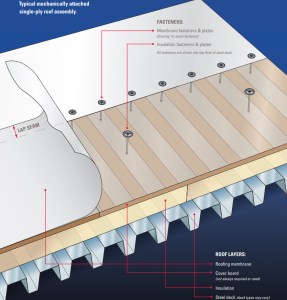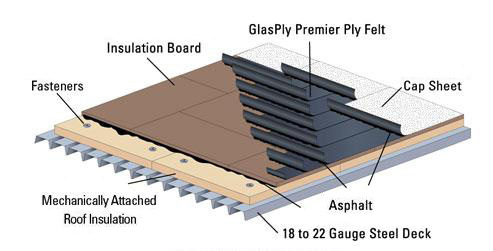You may have often wondered about the thickness of a commercial building roof, especially while gazing up at these towering structures. Well, wonder no more! In this article, we will explore the typical thickness of commercial building roofs and shed some light on why this dimension matters. So grab a cup of coffee, sit back, and let’s discover the often overlooked yet essential aspect of commercial construction.

Factors Affecting Roof Thickness
Building Size
The size of the building is one of the key factors that determine the thickness of the roof. Larger buildings require thicker roofs to provide adequate support and accommodate the additional load. The weight of the roof is directly proportional to the size of the building, so it is crucial to consider this factor when determining the appropriate thickness.
Roof Material
The choice of roof material also influences its thickness. Different materials have varying levels of durability and strength, which can affect the required thickness. For example, metal roofs are typically thinner than built-up roofing (BUR) systems. The selected material should be able to withstand the external elements, such as wind, rain, and snow, without compromising its integrity.
Climate and Weather Conditions
The climate and weather conditions of the area where the commercial building is located play a significant role in determining the roof thickness. Regions with heavy snowfall or high winds require thicker roofs to withstand the additional pressure. On the other hand, regions with hot and dry climates may require thicker roofs to provide better insulation and protection from intense heat.
Roof Design and Pitch
The design and pitch of the roof can also impact its required thickness. Roofs with complex designs or steep pitches may need thicker materials to ensure proper drainage and stability. Additionally, the pitch of the roof affects how it interacts with external elements, such as wind and rain. Therefore, it is essential to consider the design and pitch when determining the appropriate thickness.
Insulation Requirements
Roof thickness is also influenced by the insulation requirements of the building. Adequate insulation is crucial for energy efficiency and reducing heating and cooling costs. Thicker roofs can accommodate thicker insulation layers, providing better thermal performance and preventing energy loss. The insulation requirements should be taken into account to determine the optimal thickness for the roof.
Structural Support
The structural support of the building plays a significant role in determining the roof thickness. The roof must be able to bear its weight along with any additional loads, such as HVAC equipment or maintenance personnel. The strength of the supporting structure, including beams and columns, should be considered to ensure that the roof thickness is appropriate to avoid any structural issues.
Types of Commercial Roofing
Built-Up Roofing (BUR)
Built-up roofing (BUR) is a traditional and widely used roofing system that consists of multiple layers of asphalt and bitumen. The thickness of a BUR roof typically ranges from 10 to 20 millimeters, depending on the number of layers and the specific application. BUR roofs are known for their durability and resistance to weathering, making them suitable for commercial buildings.
Single-Ply Roofing
Single-ply roofing is a popular choice for commercial buildings due to its ease of installation and versatility. These roofs consist of a single layer of thermoplastic or synthetic rubber material, such as PVC, TPO, or EPDM. The thickness of single-ply roofing membranes varies depending on the specific material, ranging from 0.45 to 2 millimeters. Thicker membranes are often preferred for enhanced durability and resistance to punctures.
Metal Roofing
Metal roofing offers excellent durability and longevity, making it a popular choice for commercial buildings. Metal roofs can be made from various materials, including steel, aluminum, or copper. The thickness of metal roofing panels typically ranges from 0.5 to 1.5 millimeters, depending on the specific material and application. Thicker metal roofs provide better resistance against impact, hail, and extreme weather conditions.
Modified Bitumen Roofing
Modified bitumen roofing combines the durability of BUR systems with the flexibility of single-ply membranes. It consists of reinforcement layers and bitumen modified with polymers for improved performance. The thickness of modified bitumen roofing can vary depending on the specific product and application, typically ranging from 2 to 4 millimeters. Thicker membranes offer better protection against leaks and punctures.
Spray Foam Roofing
Spray foam roofing is a unique roofing system that provides excellent insulation and waterproofing properties. It consists of two liquid components that are mixed on-site and sprayed onto the roof surface, where they expand and form a seamless, durable membrane. The thickness of spray foam roofing typically ranges from 25 to 50 millimeters, ensuring sufficient insulation and a waterproof barrier.

Average Thickness of Commercial Building Roofs
Built-Up Roofing (BUR)
The average thickness of a built-up roofing (BUR) system for commercial buildings is around 15 to 20 millimeters. This thickness provides sufficient protection against weathering, UV radiation, and mechanical damage. The number of layers in a BUR system can vary, with each layer contributing to the overall thickness and strength of the roof.
Single-Ply Roofing
The average thickness of single-ply roofing membranes for commercial buildings varies depending on the specific material. PVC membranes typically have a thickness of 0.45 to 2 millimeters, while TPO and EPDM membranes range from 0.8 to 1.5 millimeters. Thicker membranes are often preferred for improved durability and resistance to punctures.
Metal Roofing
The average thickness of metal roofing panels for commercial buildings is between 0.5 and 1.5 millimeters. Thicker panels are commonly used in regions with harsh weather conditions to ensure better resistance against impact and extreme weather events. The thickness of metal roofing can also vary depending on the specific material, with steel roofs typically thicker than aluminum or copper roofs.
Modified Bitumen Roofing
The average thickness of modified bitumen roofing membranes for commercial buildings ranges from 2 to 4 millimeters. Thicker membranes provide better protection against leaks and punctures, ensuring the longevity and durability of the roof. The number of reinforcement layers and the specific product used can influence the overall thickness of the modified bitumen roof.
Spray Foam Roofing
The average thickness of spray foam roofing for commercial buildings is typically between 25 and 50 millimeters. This thickness ensures sufficient insulation and creates a seamless, water-tight barrier on the roof surface. The thickness of the spray foam roof can be adjusted to meet specific insulation requirements and regional climate conditions.

Importance of Roof Thickness
Energy Efficiency
The thickness of the roof plays a crucial role in the energy efficiency of a commercial building. A thicker roof with proper insulation can significantly reduce heat transfer, resulting in lower heating and cooling costs. Adequate insulation prevents thermal bridging and minimizes energy loss, providing a more comfortable indoor environment and reducing the building’s carbon footprint.
Durability and Longevity
A thick roof is generally more durable and offers better longevity. It can withstand the impact of external elements, such as rain, hail, UV radiation, and temperature fluctuations, without undergoing significant wear and tear. Thicker roofs also have better resistance against punctures and mechanical damage, ensuring a longer lifespan and reduced maintenance requirements.
Waterproofing
The thickness of the roof is directly related to its waterproofing capabilities. Thicker roofs provide better protection against leaks and moisture infiltration, preventing water damage and the formation of mold and mildew. A waterproof roof is essential for preserving the structural integrity of the building and maintaining a safe and healthy indoor environment.
Insulation
Roof thickness is closely linked to insulation levels. Thicker roofs can accommodate thicker insulation layers, providing better thermal performance and reducing heat loss or gain. This is particularly important in regions with extreme weather conditions, where adequate insulation can greatly improve energy efficiency and occupant comfort.
Fire Resistance
Thicker roofs often have better fire resistance properties. They can provide a barrier against the spread of fire and reduce the risk of ignition. Certain roofing materials, such as metal or spray foam, offer inherent fire resistance characteristics, which can be further enhanced with increased thickness. Fire-resistant roofs are crucial for commercial buildings to ensure the safety of occupants and protect valuable assets.

Factors to Consider When Determining Roof Thickness
Building Codes and Regulations
Building codes and regulations set forth by local authorities must be considered when determining the roof thickness. These codes often specify minimum requirements for roof thickness based on factors such as building size, type of occupancy, and environmental considerations. Complying with these regulations ensures that the roof meets safety standards and will pass inspections.
Type of Roofing Material
Different types of roofing materials have specific thickness requirements. Manufacturers provide guidelines and recommendations for the appropriate thickness of their products based on factors such as intended use, environmental conditions, and building codes. It is important to select a roofing material that meets the required thickness and provides the desired performance characteristics.
Roofing System Selection
The chosen roofing system affects the required thickness of the roof. Some roofing systems, such as BUR or spray foam, may require multiple layers or thicker applications to achieve the desired performance. It is essential to consider the specific requirements and limitations of the chosen roofing system to ensure proper installation and long-term functionality.
Environmental Considerations
Environmental considerations, such as the local climate, weather conditions, and sustainability goals, should be taken into account when determining roof thickness. Regions with extreme weather or high energy costs may require thicker roofs to improve insulation and energy efficiency. Additionally, sustainable building practices may prioritize the use of thicker roofs to enhance durability and reduce material waste.

Conclusion
The thickness of a commercial building roof is influenced by various factors, including building size, roof material, climate, roof design, insulation requirements, and structural support. Different types of commercial roofing, such as BUR, single-ply, metal, modified bitumen, and spray foam, have varying average thicknesses. The importance of roof thickness lies in its impact on energy efficiency, durability, waterproofing, insulation, and fire resistance. When determining roof thickness, considerations should be given to building codes, roofing material requirements, roofing system selection, and environmental factors. Overall, understanding the factors affecting roof thickness is vital in ensuring a well-designed and functional roofing system for commercial buildings.